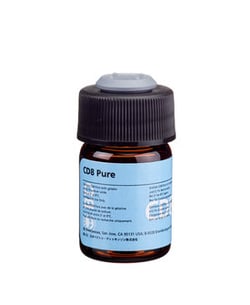Learn More
CD8 Mouse anti-Human, Unlabeled, Clone: SK1, BD
Mouse Monoclonal Antibody
Supplier: BD Biosciences 346310
Description
CD8 recognizes the 32-kilodalton (kd) α-subunit of a disulfide-linked bimolecular complex. The majority of peripheral blood CD8+ T lymphocytes expresses anα/β heterodimer (Mr 32, 30kDa), while CD8+ CD16+ natural killer (NK) lymphocytes and CD8+ T-cell receptor (TCR)-γ/δ+ T lymphocytes express an α/α homodimer (Mr 30 kd). CD8+ TCR-α/β+ T lymphocytes can express either an α/α homodimer or α/β heterodimer.The CD8 antigenic determinant binds to class I major histocompatibility (MHC) molecules, resulting in increased adhesion between the CD8+ T lymphocytes and target cells.Binding of the CD8 antigen to class I MHC molecules enhances the activation of resting T lymphocytes. The CD8 antigen is coupled to a protein tyrosine kinase, p56 lck. The CD8:p56 lck complex can play a role in T-lymphocyte activation through mediation of the interactions between the CD8 antigen and the CD3/TCR complex. The CD8 antigen is present on the human suppressor/cytotoxic T-lymphocyte subset as well as on a subset of NK lymphocytes. The CD8 antigen is expressed on 19% to 48% of normal peripheral blood lymphocytes and 60% to 85% of normal thymocytes. The CD8+ T- and NK-lymphocyte subsets can be further subdivided into the following groups: CD16+ NK lymphocytes that can express the CD8 antigen in low density; CD57+ T lymphocytes that express high-density CD8 antigen; and CD8+ CD62L+ lymphocytes that collaborate with CD8+CD62Ln++phocytes to generate suppression of B-lymphocyte function. CD8 cross-reacts with lymphocytes of some nonhuman primate species.
Host Species: Mouse
Clone: SK1
Isotype: IgG1, κ
Cross Reactivity: Human
Flow Cytometry

Specifications
| CD8 | |
| Monoclonal | |
| 12.5μg/mL | |
| Phosphate buffered saline with gelatin and 0.1% sodium azide. | |
| Human Peripheral Blood T Cells | |
| 200 Tests | |
| Immunology | |
| Human | |
| IgG1 κ |
| Flow Cytometry | |
| SK1 | |
| Unconjugated | |
| Mouse | |
| Affinity Purified | |
| RUO | |
| Primary | |
| Store vials at 2-8°C. Conjugated forms should not be frozen and should be protected from prolonged exposure to light. Each reagent is stable for the period shown on the bottle label when stored as directed. |
Your input is important to us. Please complete this form to provide feedback related to the content on this product.
For Research Use Only.
